A Gravitational Lens in Leo
3/23/2014. Gravitational lenses are among the wildest animals in the astronomical bestiary. Most are tiny (an arc second or so) and faint. Really faint. A very few (2, 3, maybe 4) are large enough and bright enough to be worth a try using a 10-inch astrograph.
One of the most prominent gravitational lenses is the Einstein ring surrounding elliptical galaxy LRG 3-757 ("LRG" stands for "Large Luminous Red Galaxy"). It was discovered in 2007 in Sloan (SDSS) images. Here's the discovery paper in the ApJ — most of the descriptive bits below are lifted from that source. Ever since NASA ran a Hubble image of the ring as an APOD, I've wondered if the subject was within reach from the backyard. It is!
The lensing galaxy is mighty, about 5.4 trillion solar masses (ten times the mass of the Milky Way). It's intrinsically bright but very distant. Its redshift (0.44) says it's on the order of 4.5 billion light years away. That would make it my most distant target ever, but that's just the beginning. Far beyond the big red galaxy is a young galaxy in a younger universe, a galaxy brilliant with newly formed stars. This one has a much larger redshift (2.379) corresponding to recession at 83% of the speed of light. It was 10.8 billion light years away when the light arriving now was emitted. Light that arrives here in the middle of the visible spectrum began in the ultraviolet (6000A here and now, 2500A then and there, which may present its own problems for photography). The light from the more distant galaxy is concentrated and warped into an almost complete ring, a horseshoe, by the gravity of the foreground galaxy. Both the lensing and lensed galaxies shine at around 19th - 20th magnitude. The ring is ~10 arc seconds in diameter. In the world of Einstein rings, that counts as "bright" and "huge."
I baked the OEM dessicant twice (it's not just a molecular sieve, now it's biscotti, too!) and shot M44 at -30°C to verify that the chip was finally dry and frost free and that the CCD was set up properly at the AT10RC's native focal length rather than the shorter effective focal length I've been using for months. Then I slewed to Regulus, recalibrated the mount, and slewed on to the coordinates of LRG 3-757.
The last time I visitted this field, I used the Ritchey at the F4.8 (1190mm) EFL I prefer for wide field views of large targets. It was just a reality check to see if any hint of the Einstein ring appeared. I didn't think it had until I recently re-examined the two year old data with fresh image processing skills. After careful signal extraction, the combined galaxies emerged as a barely discernable smudge. It was in the right location and plausibly oversized compared to field stars — in a word, it was "promising." In two, it was "damn faint."
Using the AT10RC's native focal length (F8, 1989mm) gives me a closer look. Measured FWHM PSF's were in the 3.5 to 4 arc second range. CCD Inspector reported good (but not perfect) end-to-end optical alignment, so I'm thinking that most of the excess size of the PSF's is due to turbulent air. At this focal length, the 7.4 micron pitch of my CCD corresponds to about 0.75 arc seconds per pixel. This greatly oversamples blurry stars. That suggests that I'm collecting light more slowly than if I binned the chip 2x2, but experience with other over-sampled images (all recent solar photos, for instance) tells me that tonight's data should respond well to deconvolution. Since the reality check a couple of years ago showed that detection is not an issue, resolution is the remaining challenge. One big blob won't cut it; I want to resolve the lensed and lensing galaxies. The Einstein ring should look like a ring. Using guide exposures of 15 seconds, corrections were solidly sub pixel in both axes. With the camera frost-free at last, with fresh darks and fresh flats, decently transparent if not entirely steady skies, and good guiding, what the hell? Let's take a look.
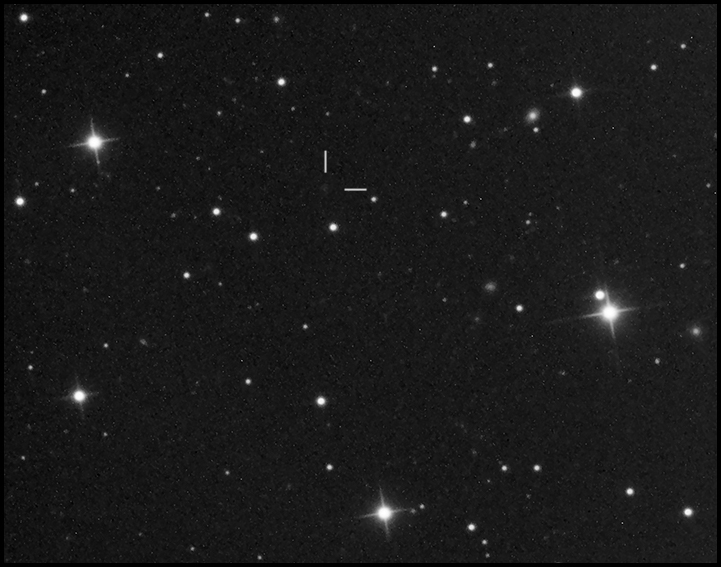
Gravitational Lens LRG 3-757
AT10RC @ F8
52x300s L (4h 20m)
ST2000XM @ -30°C
Believe it or not, if you enlarge the smudge indicated and stretch it beyond all reason, there's enough detail there to suggest that this is working out OK. Let's just keep at it and see what light through yonder telescope brings. I need better S/N and that means, as usual, more exposure (and better darks never hurt). As expected, the image sharpened up nicely. I used Richardson-Lucy deconvolution in PixInsight to compensate for very slight elongation of the stars and to tighten the point spread function toward a Gaussian ideal: PSF's in the subframes ranged from 3.8-4.2 arc seconds; in the refined image, they came down to ~2.1 arc seconds. There are 18th and 19th magnitude galaxies all over the place, especially to the left. The combined lens and ring come up in the mid- to faint 18's according to casual photometry on my images. Just a few clear, steady nights should do the trick.
I tried taking data-filet's of the best (sharpest) 29, 33, and 36 images from the final pile of 52 useful subframes, but the best results (such as they are) came from stacking every available sub. The big pile knocks down electronic noise better, and when stretching data this hard, that matters more than other factors. As the data pile grows, I'll become more selective in favor of sharper images. Tomorrow night and Wednesday, I hope.
3/26/2014. Windy and cool last night, with highly variable seeing. PSFs changed from frame to frame from good-for-here 2.8" or better to dismal-anywhere 4.0" or worse. But I started early and shot late and canned 70 frames from which to select the best. I combined 34 of these new frames with the best 20 from the previous session. I also collected 48 dark frames to help control noise and reused the previous flat (I also sampled the background at two points in the almost finished image and made a faux-flat to get rid of a residual large-scale gradient). The result is an image from the best 4h30m of exposure out of a total of 10h10m. It's worth noting that the interesting bits of this image are crowded into only about 150 grey levels out of 64,000. I've lowered the left side of the transfer function in most of the image to hide noise; the vicinity of the ring has a slightly brighter transfer function. This allows the lens to stand out more than it otherwise would. I think such local enhancement is cheating, but I want to know what's in there and see what I'm aiming at:

LRG 3-757
54x300s L (4h30m)
A spray of what would otherwise be called "background galaxies" is coming out on the left. They're probably "only" several hundred million light-years out, maybe a billion. Chickenfeed. This is coming right along.
03/27/2014. Last night was predicted to have good seeing but to cloud up in the early morning hours. Seeing was good, but persistent clouds never materialized. I only had to reject one frame for clouds. I selected 53 (out of 60) subframes, each one sharper than almost all previous frames (typical FWHM of the latest batch: 2.8"). Sharpness is critical for this target and these were very helpful. I combined the best from last night with the best stack from previous sessions and produced this image based on 8h 55m of exposure (selected from 15h 10m):

LRG 3-757
107x300s L (8h55m)
No cheating.
Things begin to shape up. I'm pushing the entire frame harder, and as you can see, the subject is not far above noise. Decon probably went a little too far; stars are hard-edged and harsh. There's just a little coma from miscollimation becoming visible, too, in the form of a slight excess fuzz on the right side of star images. Push data this hard to bring out subtle details and faults get highlighted too. Another night or two (twice the data) should smooth out the background. Also, I want color, at least in the stars. I'll leave the optics alone for now. I think I'm likely to make alignment worse before I make it better.
Earlier in the evening, while waiting for the lens to emerge from the pines, I plinked away at M35 (the 'scope was set up, and it seemed only right to use it for something), and then "discovered" NGC 2903, a beautiful spiral in western Leo (set the camera orientation index to 125° for easy guide stars). It's hard to believe that Messier overlooked this one. I only took 45 minutes of data for NGC 2903, enough to confirm that it's a lovely target deserving longer exposures and color. It's also interesting in the context of the ongoing gravitational lens project: how similar is NGC 2903 to the lensed galaxy? Except for being something like 500x closer, of course, and not sitting directly behind five trillion solar masses?
Here are a couple of what amount to snapshots. M35 (a star cluster in Gemini) and NGC 2903 (a spiral galaxy in Leo) are on the order of 10,000 - 100,000x brighter than the ring. This is what ordinary deep-sky objects look like. They're bright by comparison to the Einstein ring. Just messin' around with a backyard astrograph, don't mind me:
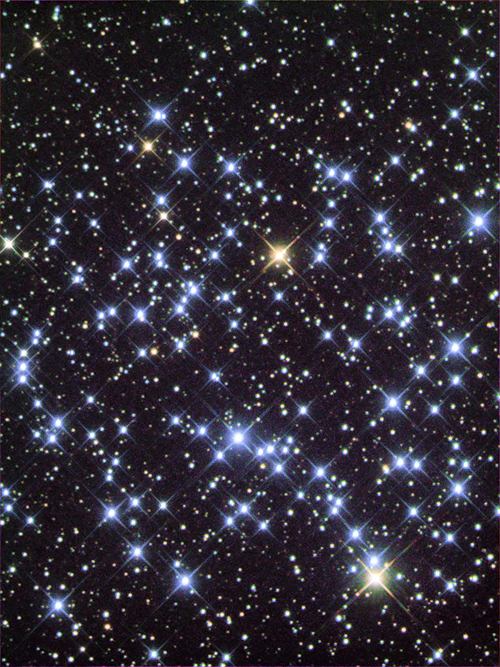
M35
6x300s L (30m), 3x300s RGB
(15m per channel)
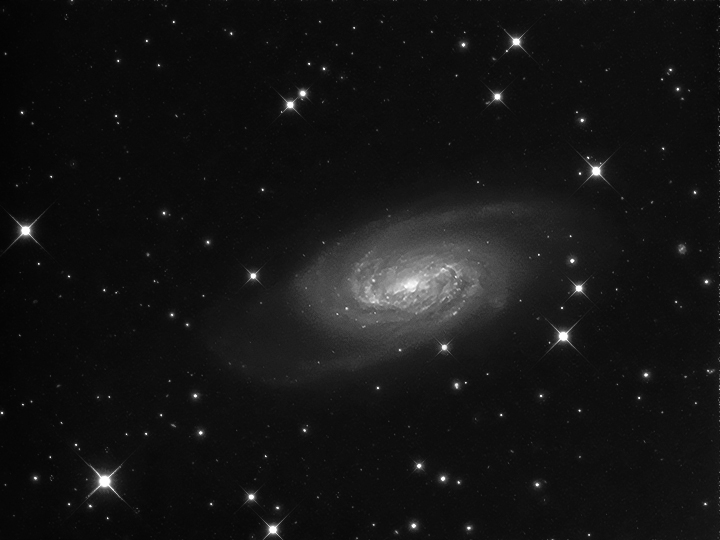
NGC 2903
9x300s (45m)
03/21/2014. We got back from our anniversary dinner (#16!) in Asheville in deep twilight. It took six minutes to go from, "Hey Honey, the sky looks pretty clear," to having everything hooked up and whirring. Imaging started 15 minutes after that, post-focus, post-cooling, post-mount-recalibration. Not bad. The seeing was dreadful, even worse than expected (FWHM PSF's 5.5 - 6 arcseconds!), so forget detail. This night was devoted to collecting color data from NGC 2903 and the field of the Einstein ring for use with the higher resolution L-frames built during the previous session.
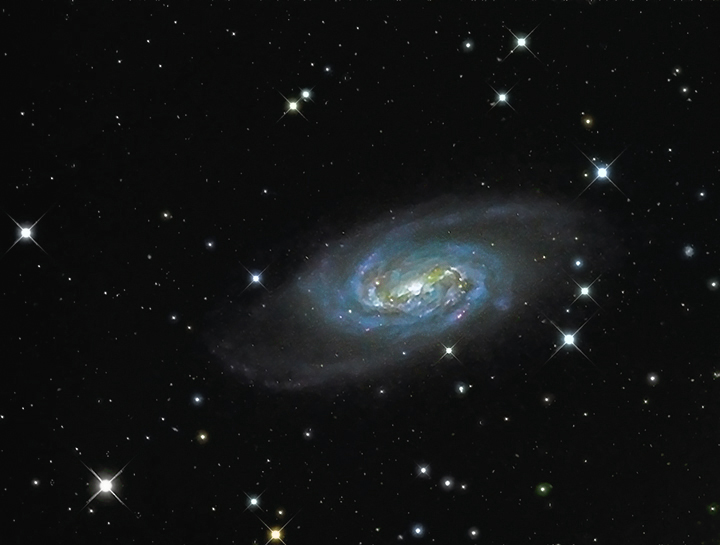
NGC 2903
9x300s (45m)
10x300s RGB (50m per channel)
(total exposure 3h 15m)
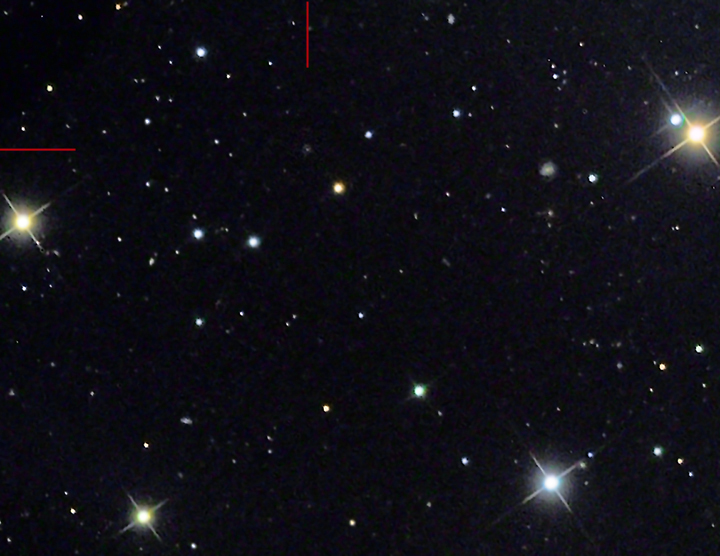
LRG 3-757
107x300s L (8h55m)
9x300s RGB (45m per channel)
(total exposure 10h 05m)
That's not awful. I only have color for the brighter stars and galaxies. The RGB images are not deep enough to provide color for the ring or for the most distant galaxies in the field. All in good time. Maybe.
The bright stars in this picture are tens of light-years away, dimmer ones are on the order of hundreds. There are at least three bright galaxies in the field which are probably outliers from galaxy cluster Abell 1367. That puts them 250,000,000 light-years away. Over on the right is a scattering of fireflies: that's a much more distant cluster of galaxies which are (by my measurement) about 3 magnitudes fainter than the Abell 1367 members. That makes them about 16x fainter which implies that they're about 4x as distant: a billion light-years, give or take. The highly luminous lensing galaxy at the center of the Einstein ring lies 4.5 billion light-years away. The small galaxy whose light is gravitationally warped into the ring is 6.3 billion light-years beyond that. At 10.8 billion light-years, this is by far the most distant object I've ever photographed, and it may be the most distant I will ever photograph. (I know I can probably find a few quasars to shoot at greater distances, but they will look only like dim stars, without structure. This is as far as I can see and see something.)
4/6/2014. I worked with more of the color data and stretched it much more aggressively. The ring shows up in R and B exposures as short as 9x300s, and 15x900s yields a pretty solid signal. I worked those up, synthesized a green channel, and added them to the 107x300s luminance frame. There was not much, if any, improvement over what's shown above, but I am encouraged about the practicality of doing a color image of the ring. One thing: all this color data reflects a night of very poor seeing. Red (and especially) blue plates from the old NGS-Palomar Sky Survey suggest that there is detail within the ring that should be within reach. I also found anoter lens to go after. Maybe two.
I examined the collimation of the RC. CCDInspector, recent images, and oversized PSFs all led me to suspect that it was just a tidge out. A careful look into the "Hall of Mirrors" suggested that one axis might be not quite perfect. One secondary screw turned out to be either loose or just on the edge of it. I snugged that one up and the hall of mirrors improved. We'll see by and by if images do as well.
I rebuilt the tabletop on which the electronics package sits. It could use a better coat of polyurethane. The old tabletop (also 3/4-inch plywood but unprotected) crumbled; if I need to replace it once every few years, I won't complain, but longer serivce would be good.
4/13/2014. The hateful Moon sits on top of my targets! I've cleaned the optics, tweaked polar alignment, touched up collimation, but I don't anticipate gathering more light from the ring for another week or longer. Images of the supernova in M82, the jet in M87, and one of the Martian moons say the 'scope is performing just fine. I'd like to revisit NGC 2903 for comparison and LRG 3-757 for real. Note that there's an article in a recent S&T about observable quasars.
On Astromart, I found a CFW-10 for an irresistable price and ordered a non-IR blocking clear glass FC-1 filter from Baader. I'm hoping the FC-1 will admit significantly more flux from the ring and its lensing galaxy. In fact, with the R-C, I hope the filter makes a difference for a lot of targets.
Things you never thought you could see (or "see"): Amalthea, Phobos & Deimos, Hubble's V1, M87's jet, a gravitational lens. Shadows of planets orbiting other stars. I haven't nailed Phobos yet, but it's just a matter of time. Sirius B is on the list. Pluto & Charon would be nice. A lunar impact? Gravitational bending of starlight at a solar eclipse? Parallax? Proper motion (should be easy).
4/21/2014. A steady night for downwind of the Blue Ridge, FWHM PSF's of 2.5 arc seconds and less. Interesting that round stars get tougher as PSFs shrink; the same drift that would make a 4" PSF 10% out of round will make a 2.5" PSF almost 25% out! Tracking needs to improve with seeing. Using a Baader "Clear" filter rather than "L" produced a decent ring image in about 4 hours total exposure. I don't have a dedicated flat for this filter and it shows. I'll get one this evening (when, weather willing, there might be a shot at both moons of Mars, too). Piling up all the ring data (178 exposures totalling 14.8 hours) is interesting; a data filet of the best 50% would probably be even more so. [The new flat helped bunches; clouds hid Mars.]
4/22/2014. Clearing skies were forecast for the small hours, so I lined up on the twin quasar in Ursa Major and let the telescope watch throughout the night. I got 41 decent luminance frames and 2 sets of RGB. PSF's went to hell late, again, but I used them anyway in the interests of knocking down sky noise. I'll try the dew shield and see if the expanding PSF's are due to focus drift or to dew on the secondary.
Inside the circle is a double star. Except it's not a double star; it's a double quasar. In fact, it's not even that: it's one quasar whose light is split by a gravitation lens. The two images have identical spectra and the light variations in one are followed by light variations in the other 417 +/- 3 days later. So light takes two paths through the geodesics of space-time; one is 8,200,000,000 light-years long and the other 8,200,000,001.2:
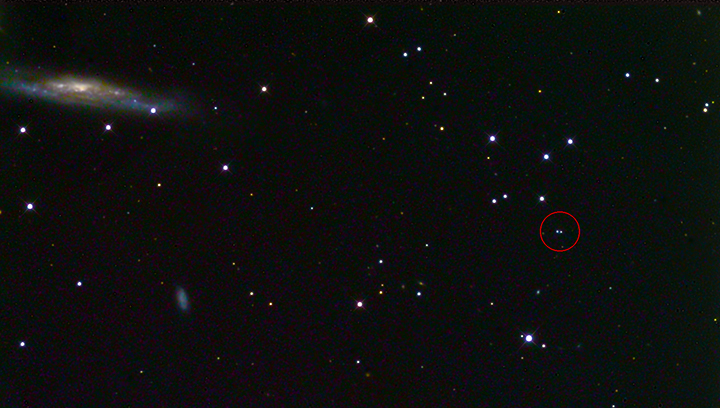
Double quasar, the first known gravitational lens (1979)
41x300s C, 2x300a RGB (4 hours total)
This is not a tough target: the double quasar shows up in 300s nicely. All the rest is is about color and smoothness and noise contol. A few beauty touches in the scattered galaxies, both near and far, depend on the extended exposure, too.
4/24/2014. Which is better: refine several nights of data then pile them up, or make a pile out of several nights' data then refine it? Or is it better still to be very selective and use only the very best data (see the 107 frame pile above). Here's the result of a big pile of passable data, about a month of images of LRG 3-757, all I have made through the L or C filters having PSF's under 5 arc seconds (212 exposures) piled up together and then refined:
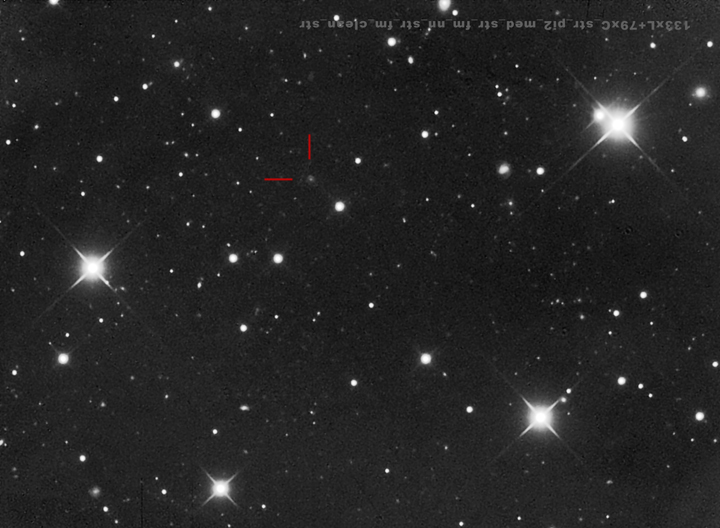
LRG 3-757
133x300s L + 79x300s C
17h 40m total exposure
Click the image for full-resolution
Here's an inverted and even more stretched version of the same data "to see what's there:"
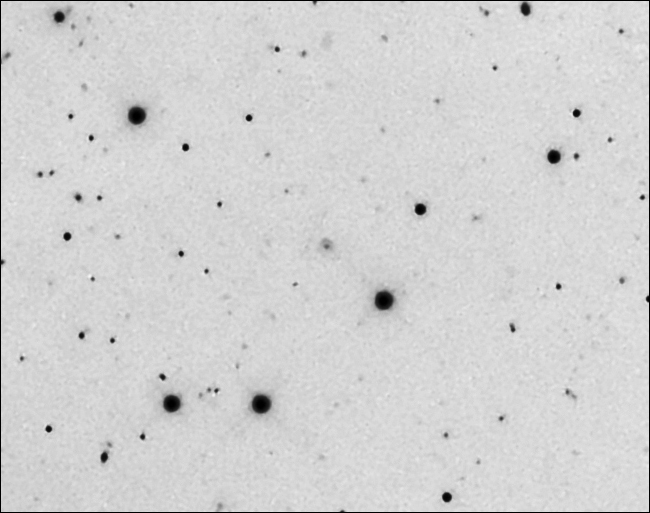
I decided to collect a lot of dark frames overnight. Here's something to remember: the camera would not cool down below -13°C (9 C° above the expected 40° delta). Turns out that you can't count on the Peltier cooler to dissipate heat when the camera is covered by the dew & pollen cover. After raising these, it promptly cooled right off. The threat of overnight rain moved me to put the cover on loosely and to direct a 12v fan into the resulting tent. Worked out well; I have fresh darks in the can for new and reprocessed imagery at both -20°C and -30°C.